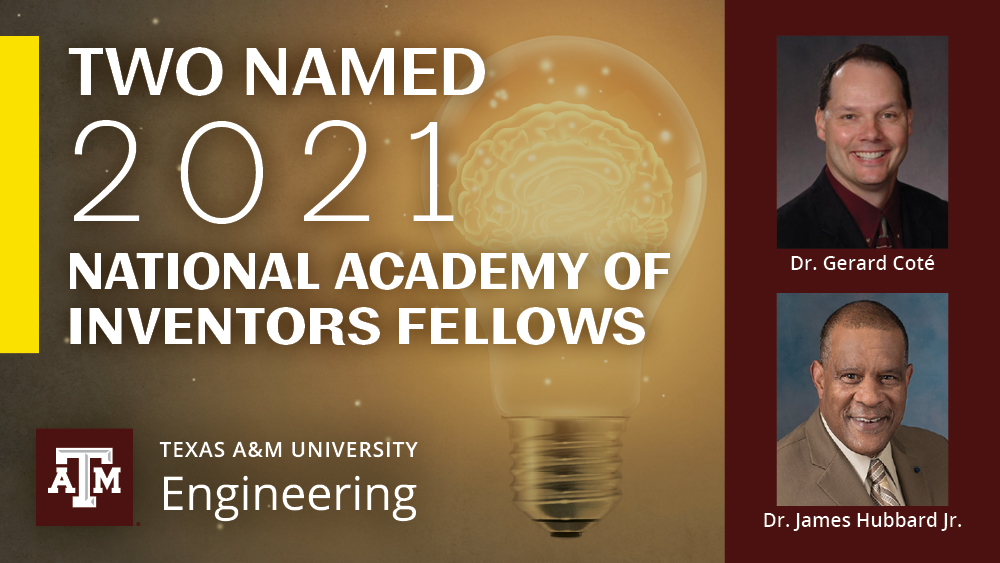
Dr. Gerard Coté and Dr. James Hubbard Jr. are among the 164 prolific academic innovators from across the world named fellow of the National Academy of Inventors. |
Image: Texas A&M Engineering
The National Academy of Inventors (NAI) has named two Texas A&M University College of Engineering faculty to their 2021 class of NAI Fellows. Dr. Gerard Coté and Dr. James Hubbard Jr. are among the 164 prolific academic innovators from across the world named fellow. Induction ceremonies will be held at NAI’s annual meeting this June in Phoenix.
The 2021 fellow class hails from 116 research universities and governmental and nonprofit research institutes worldwide. They collectively hold over 4,800 issued U.S. patents. Among the new class of fellows are 33 members of the National Academies of Sciences, Engineering and Medicine, and three Nobel Laureates, as well as other honors and distinctions. Their collective body of research and entrepreneurship covers a broad range of scientific disciplines involved with the technology transfer of their inventions for the benefit of society.
“The caliber of this year’s class of NAI Fellows is outstanding. Each of these individuals is highly regarded in their respective fields,” said NAI president Paul R. Sanberg in a press release. “The breadth and scope of their discovery are truly staggering. I’m excited not only to see their work continue but also to see their knowledge influence a new era of science, technology and innovation worldwide.”
Coté is director of the Center for Remote Health Technologies and Systems, a Texas A&M Regents Professor and holder of the James J. Cain Professorship I in the Department of Biomedical Engineering.
He holds the rank of fellow in the Institute of Electrical and Electronics Engineers, the International Society for Optics and Photonics, the Biomedical Engineering Society and the American Institute for Medical and Biological Engineering. Another recent honor includes receiving the Walston Chubb Award for Innovation from Sigma Xi, the Scientific Research Honor Society.
Coté’s research focuses on the development of macro- to nano-scale biomedical systems and point-of-care devices. Some research applications include the development of innovative, noninvasive and minimally invasive ways to test blood sugar levels in diabetes; detecting other body chemicals such as cardiac biomarkers for cardiovascular disease; the use of mobile device and optoelectronics technology to detect malaria at the point of care; and monitoring perfusion, oxygenation, heart rate, heart rate variability and cuffless blood pressure with wearable devices.
Hubbard, who serves as Oscar S. Wyatt Jr. '45 Chair I Professor in the J. Mike Walker '66 Department of Mechanical Engineering, is a member of the National Academy of Engineering. He joined Texas A&M in early 2017, first serving as a visiting fellow of the Hagler Institute for Advanced Study before accepting a permanent position.
Hubbard leads the StarLab, a state-of-the-art motion-capture research space well-suited for testing and developing new methods and technologies. He also is internationally known for his research in aeroacoustics for noise control, adaptive structures, spatially distributed transducers and the extension of modem time-domain control methodologies into the spatial domain to monitor distributed systems.
The NAI Fellows Program has 1,403 members worldwide representing more than 250 prestigious universities and governmental and nonprofit research institutes. Coté and Hubbard join 14 current or past Texas A&M faculty members selected as NAI Fellows.
The 2021 fellow class hails from 116 research universities and governmental and nonprofit research institutes worldwide. They collectively hold over 4,800 issued U.S. patents. Among the new class of fellows are 33 members of the National Academies of Sciences, Engineering and Medicine, and three Nobel Laureates, as well as other honors and distinctions. Their collective body of research and entrepreneurship covers a broad range of scientific disciplines involved with the technology transfer of their inventions for the benefit of society.
“The caliber of this year’s class of NAI Fellows is outstanding. Each of these individuals is highly regarded in their respective fields,” said NAI president Paul R. Sanberg in a press release. “The breadth and scope of their discovery are truly staggering. I’m excited not only to see their work continue but also to see their knowledge influence a new era of science, technology and innovation worldwide.”
Coté is director of the Center for Remote Health Technologies and Systems, a Texas A&M Regents Professor and holder of the James J. Cain Professorship I in the Department of Biomedical Engineering.
He holds the rank of fellow in the Institute of Electrical and Electronics Engineers, the International Society for Optics and Photonics, the Biomedical Engineering Society and the American Institute for Medical and Biological Engineering. Another recent honor includes receiving the Walston Chubb Award for Innovation from Sigma Xi, the Scientific Research Honor Society.
Coté’s research focuses on the development of macro- to nano-scale biomedical systems and point-of-care devices. Some research applications include the development of innovative, noninvasive and minimally invasive ways to test blood sugar levels in diabetes; detecting other body chemicals such as cardiac biomarkers for cardiovascular disease; the use of mobile device and optoelectronics technology to detect malaria at the point of care; and monitoring perfusion, oxygenation, heart rate, heart rate variability and cuffless blood pressure with wearable devices.
Hubbard, who serves as Oscar S. Wyatt Jr. '45 Chair I Professor in the J. Mike Walker '66 Department of Mechanical Engineering, is a member of the National Academy of Engineering. He joined Texas A&M in early 2017, first serving as a visiting fellow of the Hagler Institute for Advanced Study before accepting a permanent position.
Hubbard leads the StarLab, a state-of-the-art motion-capture research space well-suited for testing and developing new methods and technologies. He also is internationally known for his research in aeroacoustics for noise control, adaptive structures, spatially distributed transducers and the extension of modem time-domain control methodologies into the spatial domain to monitor distributed systems.
The NAI Fellows Program has 1,403 members worldwide representing more than 250 prestigious universities and governmental and nonprofit research institutes. Coté and Hubbard join 14 current or past Texas A&M faculty members selected as NAI Fellows.